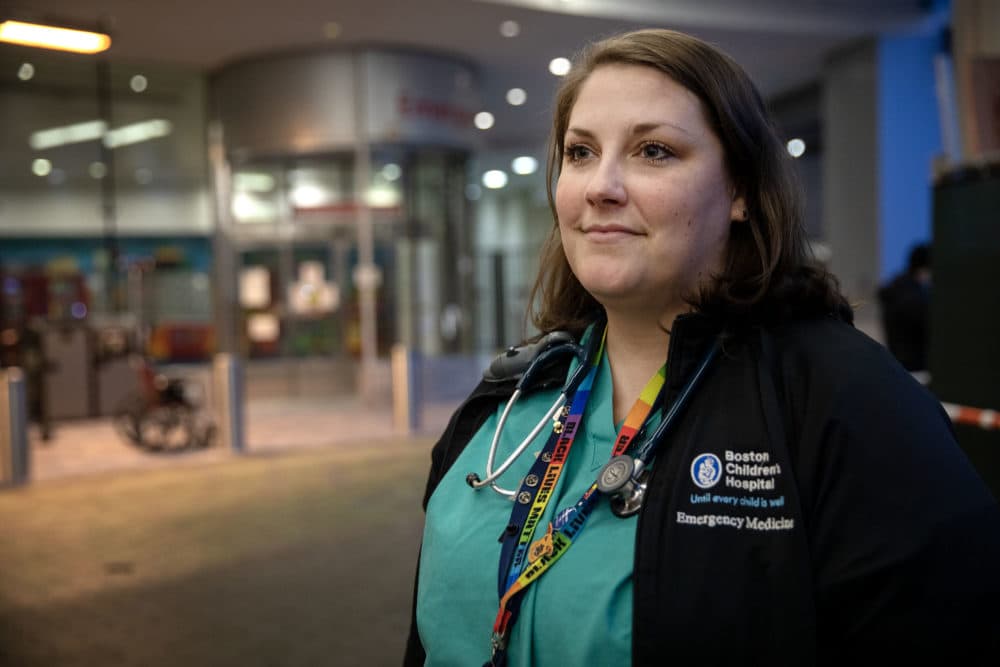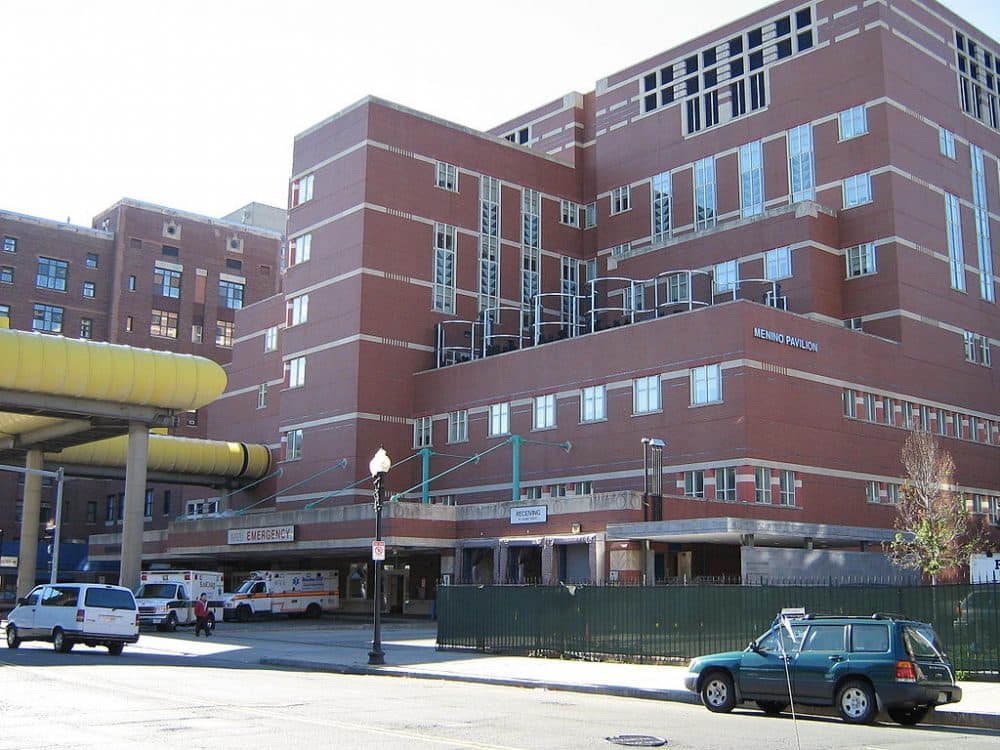Advertisement
In record numbers, families without shelter are turning to Massachusetts emergency departments
Play
A relentless headache first brought Oscar to the emergency department. But it was a lack of housing that sent her, and her 8-year-old son, back the next night.
In late November, they stepped off a bus and onto Massachusetts soil for the first time. They hoped this would be the final stop in a five-year journey from Haiti, through South and Central America, to the United States.
“The situation was really stressful,” Oscar said through a translator. She didn’t know anyone in Massachusetts, and she felt scared and alone, she said.
At the bus terminal, she asked a taxi driver to take them to the emergency room. WBUR is using her middle name because her family was a target of violence in Haiti.
In the ER, Oscar confided in a doctor that she and her son had nowhere to live.
The next morning, hospital staff sent them to a field office for the Department of Housing and Community Development, the state agency that runs the family shelter system. But by the end of the day, their application was still underway, and they had nowhere to go.
Oscar recalls frantically searching for a staff member who spoke Haitian Creole. When she found one, she asked him what to do.
“He told me to go back to the hospital and explain to them that I don’t have anywhere to go,” Oscar said.
The man called a car through a ride-hailing app. In pouring rain, Oscar and her son returned to the emergency department at Boston Medical Center.
This story, or one like it, is playing out again and again in Massachusetts hospitals.
Emergency departments are already packed with patients in a season of spiking respiratory viruses , but they are also seeing another kind of patient. One that doesn’t need emergency medical care. Families experiencing homelessness are turning to Massachusetts emergency departments in record numbers.
Often these families have nowhere else to go during their critical first few days of homelessness. The emergency room — where there’s a roof, food and a team of social workers — provides an alternative to sleeping outdoors or in a car, if the family has one.
While ERs across the country have long been a place where people experiencing homelessness can go for help, the numbers have ballooned lately. In Massachusetts, the arrival of new immigrants fleeing violence and unrest in places like Haiti and Venezuela, has collided with high housing costs pushing more families into homelessness.
"We're really trying to avoid this becoming our new normal."
Megan Sandel, Boston Medical Center
And Massachusetts is in a unique situation. It is the only state in the country with a legal “right to shelter” for eligible families. But the application process for state-run shelters can be lengthy, and the state’s field offices and hotline close after business hours, leaving some families in the lurch.
“They're choosing between a bunch of really terrible options,” said Amanda Stewart, a physician in the emergency department at Boston Children’s Hospital. “I think that's how we end up becoming this kind of front door to the shelter system.”
Two cities — New York City and Washington, D.C. — also promise a “right to shelter,” but experts in both places say local provisions often prevent families from being routed to the ER as readily. In New York City, families are given a place to stay while they apply for the shelter system. If they don’t qualify, they are told to leave.
In Massachusetts, the state-run system only provides shelter once a family is deemed eligible. So, as families work through the application, they sometimes seek help in emergency departments.
Stewart and others warn that ERs are not ideal places for families in need of shelter. Staying there can take a toll on family members' mental and physical health, and on the medical system.
“We're really trying to avoid this becoming our new normal,” said Megan Sandel, a physician at Boston Medical Center, who has been working on housing and homelessness for 20 years.
'It’s massive,' and it’s tedious
About a decade ago, families experiencing homelessness started showing up in the state’s emergency departments in significant numbers. But recently, the numbers have ballooned as an affordable housing crisis collides with a spike in new migrants arriving in the state.
In 2014, the emergency department at Boston Children’s Hospital saw 51 families whose primary concern was housing. This year, the hospital is on track to see 550 families seeking shelter.
“It’s massive,” said Melissa Deane, who oversees social workers in that emergency department. “We have had to dedicate, I would say, close to 40% of our social work resources to this problem. ”
Like Oscar, many families tell Deane that state field office staff directed them to the ER. Others are sent by taxi drivers, airport workers, friends, relatives and even strangers.
State officials declined to be interviewed for this story but said through a spokesperson that it is not their policy to send families to emergency departments. And yet, the way the state's shelter system works, along with the lack of other options, is driving families to hospitals when they need shelter.
At first, it was a change in state policy that made emergency rooms seem like a good option for families without housing. A night in the ER demonstrated that they were staying in a place the state considered unfit for human habitation. This made it easier to qualify for the shelter system.
The Legislature changed this policy in 2019, but hospitals say families continued to arrive. And emergency department social workers kept helping them apply for shelter — in addition to serving all the other families facing traumas, like car accidents, deaths or domestic violence.
One challenge for hospital staff is that the process of applying for state shelter has become more onerous over time. A 1983 state law required Massachusetts to provide temporary shelter for any pregnant person or family experiencing homelessness. There were income limits, but advocates say qualifying was fairly straightforward.
“Over the years, layers and layers of requirements were added,” said Kelly Turley, associate director of the Massachusetts Coalition for the Homeless.
“Over the years, layers and layers of requirements were added.”
Kelly Turley, Mass. Coalition for the Homeless
It can take Deane’s team days to track down everything families need. Deane described combing through online financial transactions, and tracking down multi-year housing histories, bank statements and birth certificates.
“It's very intensive case management that we're doing,” she said. “And just constant communication back and forth with [state workers] to make certain that the documents that we're sending are being received and are being interpreted the way that we're understanding [them].”
The cost of waiting in the ER
When a family in need of shelter comes to the emergency department at Boston Children’s, staff try to find a better alternative. Deane said this can sometimes mean encouraging a family to move to another state or country where they can stay with friends and relatives.
Yet for the majority of families seen at Boston Children’s, there are no other viable options. These families often stay at the hospital as they work through the shelter application. Their stays can last hours, days or much longer.
One family stayed for nearly a month. They didn’t qualify for the state’s shelter system, and hospital social workers scrambled to find other accommodations, Deane said.
While the length of this family’s stay was unusual, it demonstrates the difficulty of using emergency departments as temporary shelters, and the lengths hospital staff sometimes have to go to when they help families.
For families, a stay in the emergency department at Boston Children’s involves a complex, daily cycle of being admitted to the ER, discharged and then readmitted the next night.
What this means, in practice, is that families often spend their days sitting in the waiting room or the hospital’s family center. Eventually, the children are evaluated by a clinician and checked into the ER, which gives the family a room for the night. In the morning, they are discharged back to the waiting room, and the process repeats itself.
While waits in emergency departments are often long, lately they’ve become even longer. The surge of patients seeking treatment for respiratory illnesses and other medical concerns has strained hospital resources, and families who need shelter are among the last in line.
“Children who are there for homelessness will end up waiting until essentially the rest of the children — that are there for medical concerns — have already been seen,” said Stewart, the emergency department doctor. Even in the best of times, “often these children didn't get rooms until two or three or four in the morning,” she said.
Recently, she said, families remain in the emergency department waiting room all night, sleeping on cushioned benches.
“There are alarms going off 24/7. There's just lots of potentially scary things happening,” Stewart said. “Not to mention, of course, there's infectious diseases that we don't need to expose them to if they aren't there for medical reasons.”
“Often these children didn't get rooms until two or three or four in the morning.”
Amanda Stewart, Boston Children's Hospital
The situation is “heart wrenching,” Stewart said, and it’s expensive.
When Stewart delved into the data in 2018, she found that health insurers were paying, on average, over $550 per night, per child. And usually, it was the state’s Medicaid system that picked up the tab.
“It was about four and a half times the cost of a night in shelter,” she said. “These are just completely preventable, unnecessary costs to the health care system.”
The state’s Department of Housing and Community Development declined to address questions about how many families come into the shelter system through hospital emergency rooms, but the department said it continues to work closely with hospitals and advocates, and is taking steps to improve the system.
The state is also taking steps to increase the number of family shelter beds. In a letter to the Legislature last month requesting additional funds, Gov. Charlie Baker wrote of “a dramatic increase in demand for emergency shelter.”
Earlier this month, the state opened a new shelter intake center in Devens. However, advocates say the facility is being used for families that have already entered the shelter system, not those still completing the application process.
Getting out of the ER
When Oscar and her 8-year-old returned to Boston Medical Center for a second night, it was not surprising for hospital staff.
Since the spring, BMC clinicians have noticed a substantial increase in families experiencing homelessness showing up in their emergency department, especially families from Haiti and other countries.

Hospital officials declined to provide specific numbers, but the increase concerned them enough that they started looking for other solutions.
“We don't think this is the right place to come,” said Sandel, the BMC physician. “And so we really want to think about ways in which to have new systems set up.”
One of those new systems came in the form of six apartments and seven hotel units.
The hospital partnered with the city and FamilyAid Boston, a large nonprofit, to create 24-hour access to short-term housing in those units.
“When the hospital calls, we send a staff person to meet with the family to help settle them in the middle of the night,” said Larry Seamans, president of FamilyAid.
FamilyAid social workers take families from BMC to one of the apartments or a hotel room. From there, they can gather documents and help the family apply for the state’s shelter system.
Since July, Seamans said a couple hundred families have gone through the program. He said 95% of them ended up in the state shelter system, and the average stay at the FamilyAid unit was 15 days.
But, Seamans said, the program often doesn't have enough space to serve all of the families arriving at BMC’s emergency department.
Seamans used to work in the shelter system for single adults — which is run by nonprofits — and he said a bed is available there any time of night, any day of the year. Many advocates say the state-run family shelter system should work the same way.
Despite serving thousands of families each month, Seamans said the family shelter system is in dire straits.
“It can't expand fast enough to meet the people in the moment,” he said. “So families are going in droves to the hospitals.”
"It can't expand fast enough to meet the people in the moment. So families are going in droves to the hospitals."
Larry Seamans, FamilyAid
Oscar and her son were among the lucky ones. When BMC called FamilyAid, there was a spot available. Instead of sleeping in the ER for a second time, they were taken in the middle of the night to a hotel room. Oscar said it was the first time she was able to relax.
After 10 days at the hotel, she and her son received a shelter placement. They packed all their belongings into a couple of bags.
Oscar said her hope is a simple one: to find stability and a school for her son.
As they got into a taxi, Oscar and her son smiled and waved goodbye to their FamilyAid case worker. With help from the nonprofit and the emergency department, they had made it through the state shelter system’s front door.
This article was originally published on December 22, 2022.
